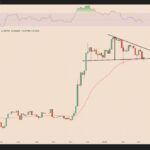The cryptocurrency landscape is currently facing a turbulent phase, coinciding with shifts in traditional financial markets. Recent patterns reveal that as the Nasdaq index has experienced a downturn, bitcoin (BTC) has also followed suit. This decline appears to correlate closely with rising yields on Japanese government bonds and a strengthening of the Japanese yen (JPY), reminiscent of market conditions observed in early August.
The behavior of the yen has historically influenced global asset prices, leading to speculation that the recent uptick in JPY is contributing to the current risk-averse sentiment on Wall Street and in the crypto arena. According to data from the Commodity Futures Trading Commission (CFTC) captured by MacroMicro, speculative positions in the yen have reached unprecedented highs. Such extreme bullish sentiment can often lead to a market correction, where overly optimistic investors may swiftly unwind their positions when expectations are not met.
“We are now cautious on chasing further JPY strength, given stretched speculative positioning as well as strong dip-buying appetite from the domestic community,”
stated Morgan Stanley’s G10 FX Strategy team in a recent client communication. They observed that many Japanese investors are utilizing the Nippon Individual Savings Account (NISA) scheme to invest in foreign assets during risk-averse phases. This trend could also contribute to the slowing appreciation of the yen. Additionally, the public pension system often acts contrary to current trends, adjusting their portfolios to mitigate risk.
Drawing parallels to last August, significant yen appreciation preceded notable sell-offs in equity markets. In that scenario, both the Nasdaq and bitcoin rebounded sharply after the yen’s rise subsided. At present, bitcoin is hovering around ,300, showing a decline of nearly 5% over the month and extending February’s notable dip of 17.6%.
In the currency market, the USD/JPY pair is currently trading at 147.23 after reaching a recent five-month low of 145.53. This context suggests potential short-term relief for risk assets, but the broader outlook for the yen remains bullish due to narrowing U.S.-Japanese bond yield differentials. As these financial dynamics continue to evolve, market participants are encouraged to remain vigilant for any signs of volatility that could impact both traditional and digital asset markets.

Market Dynamics: JPY, Nasdaq, and Bitcoin
The recent fluctuations in the financial markets, particularly involving the Japanese yen, Nasdaq, and Bitcoin, reveal interconnected dynamics that could impact investors and traders. Here are the key points to consider:
- Correlation Between JPY and Risk Assets:
- The rising Japanese government bond yields and strengthening yen have coincided with a decline in Nasdaq and Bitcoin prices.
- This mirrors market conditions from early August, suggesting a possible causational relationship.
- Impact of Speculative Positioning:
- Record bullish positioning in JPY could lead to market corrections if expectations are not met, potentially causing a swift reversal in the current trend.
- A high level of speculation may create vulnerabilities in the market, leading to increased volatility.
- Consumer Behavior and Investment Strategies:
- Japanese investors often utilize the Nippon Individual Savings Account (NISA) to diversify into foreign assets during risk-off periods.
- The public pension fund’s actions tend to counteract yen strength, affecting market dynamics.
- Historical Precedent:
- Past instances indicate that sharp yen appreciation led to significant sell-offs in equities and could do so again.
- The potential for risk-on sentiment may prevail, offering opportunities for assets like Nasdaq and Bitcoin to recover.
- Current Market Conditions:
- Bitcoin is currently facing downward pressure, trading around ,300 after significant declines.
- The USD/JPY exchange rate is at a five-month low, influencing the outlook for these risk assets.
- Monitoring Market Volatility:
- Investors should remain alert for signs of volatility related to the yen and broader financial market trends.
- The narrowing yield spread between U.S. and Japanese bonds suggests a critical shift in the JPY outlook that could impact risk assets.
“Caution is advised in chasing further JPY strength, as speculative positioning appears overstretched.” – Morgan Stanley G10 FX Strategy team
Market Movements: The Yen’s Impact on Nasdaq and Bitcoin
The interplay between the Japanese yen’s strength and the performance of risk assets like the Nasdaq and bitcoin is becoming increasingly pronounced. Recent trends indicate that as Japanese government bond yields rise, so does the appeal of the yen as a safe-haven currency, ultimately leading to a retreat in high-risk asset prices. This pattern isn’t entirely new; similar dynamics were observed in August, suggesting a possible correlation that could reshape investor sentiment.
On the one hand, the current bullish trend in the yen presents a solid advantage for Japanese investors looking to capitalize on foreign assets. The insistence on maintaining JPY positioning, backed by historical behavior, seems to support a prolonged phase of cautious investment. Financial strategists from Morgan Stanley have pointed out that a surge in domestic investments through the Nippon Individual Savings Account (NISA) can create a stabilizing counterforce against ultra-strong yen valuations. This creates a safety net for those navigating the volatile waters of global equities and cryptocurrencies, which can be particularly attractive during risk-off periods.
However, the dramatic bullish posture among speculators can pose significant risks. Should the yen’s ascent falter—as historical trends suggest—the abrupt unwinding of long positions could trigger a rapid bearish pivot in both the yen and, consequently, in the Nasdaq and bitcoin. Investors should be wary of the feedback loops created by collective market sentiment. If the anticipated dip-buying from local investors doesn’t materialize, the consequences could be severe, unleashing more negative pressure on assets like the Nasdaq and BTC.
For industry participants, including crypto enthusiasts and equity traders, the immediate advantages of these market shifts may quickly turn into challenges. Those positioned to benefit are Japanese investors and global asset managers adept at recognizing these market movements. Conversely, traders in the cryptocurrency realm may face hurdles if the yen’s strength continues to upend market expectations, thereby limiting their potential for gains.
Moreover, as the bond yield spread between the U.S. and Japanese government bonds narrows, this environment could prove detrimental to risk assets in the short term. Maintaining vigilance is essential, as financial markets are known for their volatility and sudden shifts driven by external factors like monetary policy and geopolitical events. Thus, while opportunities abound, the landscape is fraught with complexities that require careful navigation.

















